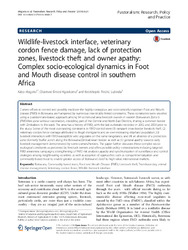| dc.contributor.author | Mogotsi, Kabo | |
| dc.contributor.author | Kgosikoma, Olaotswe, Ernest | |
| dc.contributor.author | Lubinda, Keotshepile, Enerst | |
| dc.date.accessioned | 2022-03-07T09:30:50Z | |
| dc.date.available | 2022-03-07T09:30:50Z | |
| dc.date.issued | 2016-10-26 | |
| dc.identifier.citation | Mogotsi, K., Kgosikoma, O. E., & Lubinda, K. F. (2016). Wildlife-livestock interface, veterinary cordon fence damage, lack of protection zones, livestock theft and owner apathy: Complex socio-ecological dynamics in Foot and Mouth disease control in southern Africa. Pastoralism, 6(1), 1-12. | en_US |
| dc.identifier.issn | 2041-7136 | |
| dc.identifier.uri | https://link.springer.com/article/10.1186/s13570-016-0068-7 | |
| dc.identifier.uri | https://hdl.handle.net/13049/378 | |
| dc.description | This article is distributed under the terms of the Creative Commons Attribution 4.0 International License (http://creativecommons.org/licenses/by/4.0/), which permits unrestricted use, distribution, and reproduction in any medium, provided you give appropriate credit to the original author(s) and the source, provide a link to
the Creative Commons license, and indicate if changes were made. | en_US |
| dc.description.abstract | Current efforts to control and possibly eradicate the highly contagious and economically important Foot and Mouth disease (FMD) in Botswana are hampered by numerous inextricably linked constraints. These constraints were unveiled using a questionnaire-based approach among 94 communal area livestock owners in eastern Botswana’s Zone 6 (FMD-free zone without vaccination, straddling part of the Central and North East Districts, sharing a common border with Zimbabwe to the east). The area has a history of FMD, with the last outbreaks recorded in 2002 and 2003 prior to the study. Some of the most outstanding constraints in FMD control were (1) rampant cross-border livestock theft, (2) veterinary cordon fence damage attributed to illegal immigrants and an ever-increasing elephant population, (3) livestock interaction with FMD-susceptible wild ungulates on the same rangelands, and (4) an absence of a protection zone (formerly ‘buffer zone’) along the Botswana/Zimbabwean border as well as (5) general apathy towards daily livestock management demonstrated by some owners/herders. The paper further discusses these complex socio-ecological constraints as perceived by livestock owners and offers possible policy considerations including targeted FMD awareness campaigns, strengthening of FMD risk analysis capacity and synchronization of surveillance and control strategies among neighbouring countries as well as adoption of approaches such as compartmentalization and commodity-based trade to enable greater access of Botswana’s beef to high-value international markets. | en_US |
| dc.language.iso | en | en_US |
| dc.publisher | Springer Open | en_US |
| dc.relation.ispartofseries | Pastoralism;6(1), 1-12. | |
| dc.subject | Botswana | en_US |
| dc.subject | Commodity based trade | en_US |
| dc.subject | Foot and Mouth Disease (FMD) | en_US |
| dc.subject | Livestock theft, | en_US |
| dc.subject | Transboundary animal disease management | en_US |
| dc.subject | Veterinary cordon fence | en_US |
| dc.subject | Wildlife livestock interface | en_US |
| dc.title | Wildlife-livestock interface, veterinary cordon fence damage, lack of protection zones, livestock theft and owner apathy: Complex socio-ecological dynamics in Foot and Mouth disease control in southern Africa | en_US |
| dc.type | Article | en_US |

